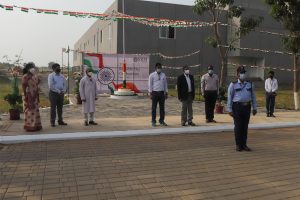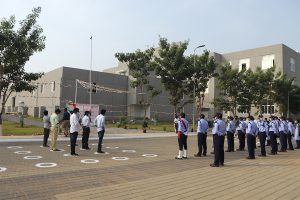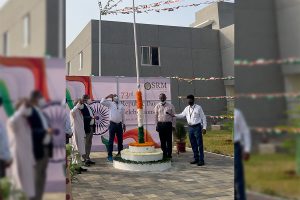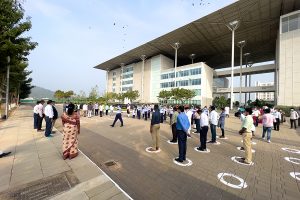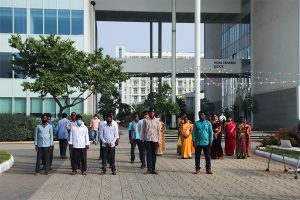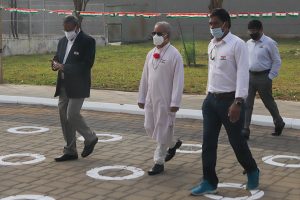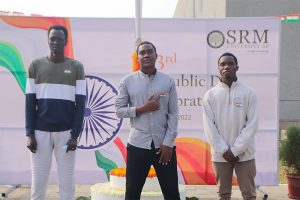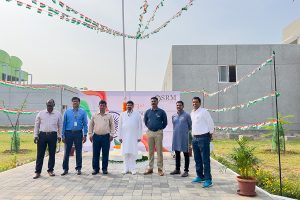Students distribute winter clothing among slum dwellers
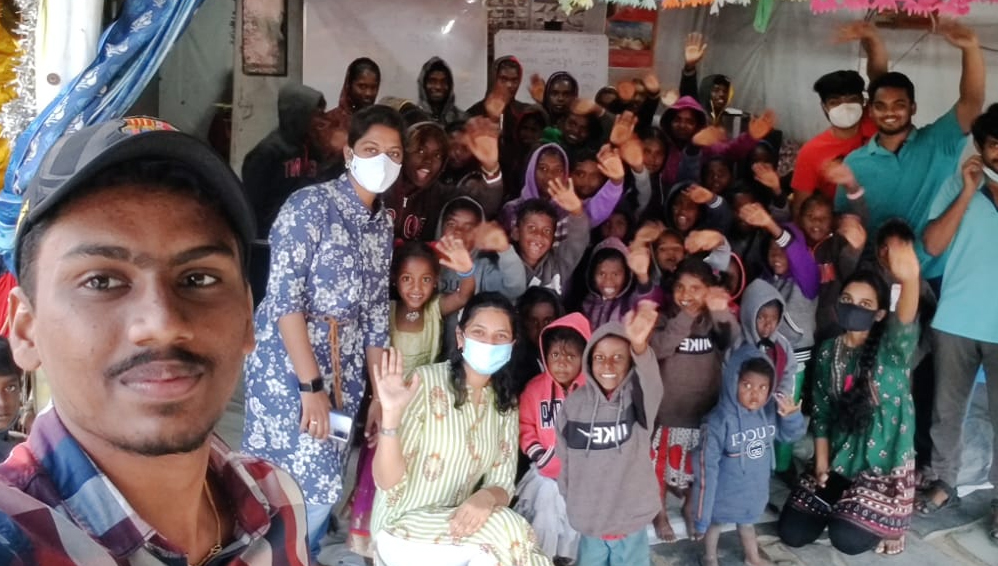 In a major initiative by the students of SRM University-AP, sweaters were distributed among the poor kids living on the streets of Guntur. Under the initiative, students from the 2018 batch of Computer Science Engineering, Civil Engineering, Mechanical Engineering, Electronics and Communication Engineering, and Management Studies visited slum areas on the roadside near Shri Hospital, Guntur and distributed clothing among 44 kids ranging from 3 to 16 years old.
In a major initiative by the students of SRM University-AP, sweaters were distributed among the poor kids living on the streets of Guntur. Under the initiative, students from the 2018 batch of Computer Science Engineering, Civil Engineering, Mechanical Engineering, Electronics and Communication Engineering, and Management Studies visited slum areas on the roadside near Shri Hospital, Guntur and distributed clothing among 44 kids ranging from 3 to 16 years old.
“We know how the families whose sustenance depends on the street have suffered during the pandemic. I am sure these small acts will bring cheers to these families,” said Prof V S Rao– Vice-Chancellor of the university. Prof B V Babu– Dean, School of Engineering and Sciences- highlighted the wonderful gesture saying “I am really glad to see the sensitivities and sensibilities our students have in sharing and giving”. Ms Revathi Balakrishnan– Assistant Director, Student Affairs appreciated the efforts, selfless service and compassion of SRM AP students to the lesser privileged.
- Published in CIVIL NEWS, CSE NEWS, ECE NEWS, Mechanical Engineering NEWS, News
Student venture enters global market with $500K investment from Y-Combinator
 There is nothing more satisfying for a university to see its students achieving their dreams, scaling greater heights. What Sourav Sanyal and Miran Junaidi started as a curious, entrepreneurial adventure during their undergraduate studies has turned out to be a robust business plan attracting investors across the world.
There is nothing more satisfying for a university to see its students achieving their dreams, scaling greater heights. What Sourav Sanyal and Miran Junaidi started as a curious, entrepreneurial adventure during their undergraduate studies has turned out to be a robust business plan attracting investors across the world.
OurEye.ai was founded by the duo to provide an automated, end-to-end video intelligence solution for enterprises to monitor surveillance cameras in real-time, leveraging pre-existing CCTV-IP infrastructure. The founders secured an angel investment of $1,20,000 during the initial phase itself from top VC’s and angels in India. On this date, the company has attracted another renowned global accelerator and Investor Y-Combinator with an investment offer of $500K (about INR 3.7 Cr) in OurEye.ai. This remarkable achievement also takes the total amount invested in the company close to $620K (INR 4.7 Cr) in a little more than 12 months since inception. No wonder the duo is celebrating with all their hearts.
Y Combinator (YC) is one of the top American silicon-valley-based startup accelerators that funds the top companies of the world. YC has programmes, resources, and a community that supports founders throughout the company’s life. Airbnb, DoorDash, Stripe, Dropbox, CoinBase, Reddit, Instacart & Ginkgo Bioworks are a few of the prominent unicorns that were part of the past YC collaborations.
“With the beginning of 2022, we embark on a new journey of Bringing Cameras to Life and creating analytics for the offline world with the help of billions of CCTV infrastructure that has existed for over a decade. Now with YC’s support, we wish to do more,” said Miran Junaidi, Co-Founder of the Company.
“It has been the most exciting ride of my life. Starting up with OurEye.ai while in university to graduating a couple of months ago with a major dream come true. We have learnt a lot and learnt it the hard way that ‘Idea isn’t king, execution is’. It has been the best couple of years, and there could not be a better time to start up. After testing and executing the waters on the national market, we are now aiming to expand in the global market and grow at lightspeed.” said Sourav Sanyal, Founder of the Company.
“Y-Combinator picks just about 70 or fewer startups from India over 2 batches every year. This is a major milestone for our students and their startup. Miran and Sourav were extremely passionate about their company from the initial days. That is what motivated the world’s largest startup accelerator to believe in their startup. I am confident that investors and customers around the world will soon reinforce that belief and propel them to unicorn status,” said Dr Sathyanarayanan, President of the University.
“We take immense pride and happiness in our student’s achievements, and this is still just the beginning. I am certain that this milestone will continue to inspire not only our current students but also all the students out there with entrepreneurial ambitions. Here, at SRMAP, our primary focus is to bring out the best among our students, be it research, entrepreneurship or higher studies,” said Prof V S Rao, Vice-chancellor, SRM University-AP.
- Published in CSE NEWS, News, Students Achievements
Dr Jagadish influenced the young brigade of SRMAP on the making of self-reliant India
“Using Light to Sense and Interface humans could be the 4th Industrial Revolution,” said Dr Chennupati Jagadish, a distinguished professor in Physics in the Research School of Physics and Engineering at the Australian National University in his talk on “Semiconductor Nanostructures for Optoelectronics Applications” in the fourteenth edition of the University Distinguished Lecture Series conducted by SRM University-AP, Andhra Pradesh on January 22, 2022.
The event was inaugurated by Prof V S Rao, esteemed Vice-Chancellor (SRM University-AP). The revered Pro-Vice-Chancellor (SRM University-AP), Prof D Narayana Rao, powerfully emphasised on event’s motives, vision, and outreach, “Universities are creators of new knowledge, innovative ideas, and providers of talented and skilled manpower to the world.”
Dr Jagadish was honoured as Champion of the Order of Australia for his eminent contributions to Physics and Engineering at the Australia Day Honours 2016. He has acquired the IEEE Pioneer Award in Nanotechnology (2015), the Walter Boas Medal from the Australian Institute of Physics (2013) and the Thomas Ranken Lyle Medal from the Australian Academy of Science (2019).
Dr Jagadish has led the Semiconductor Optoelectronics and Nanotechnology Group as its head since its establishment in 1990 by him. He believes that digital and biological technology will merge in the fourth industrial revolution. As 90% of our information is received by light, the Optical and photo-electronics based trillion-dollar industries will double in their value by 2030. He addressed the growing interest in research and analysis on nanowires in the field of electronics and communications, which could have far-reaching benefits. He noted that the development of nanowires could address a wide range of challenges in science and technology.
The developing research in Augmented Reality, Wearable Optical Sensors, Holographic Displays etc. and the people working on it as the students and staff at SRM University-AP stand to enhance the market and build upon the vision of a self-reliant India, according to Dr Jagadish.
His talk elaborated on the ongoing research, challenges and possibilities of development in this sector, and he concluded on the optimistic note that more and more researchers would come up with new ideas or world-changing solutions.
The event series was attended by over 2300 members from varying walks of the science field from IITs, NITs, IISERs, Universities and Institutions, CSIR, DST, DBT, DRDO, DAE, ISRO, NARL, MoES and several others from different parts of the country.
- Published in News
73rd Republic Day Celebrations
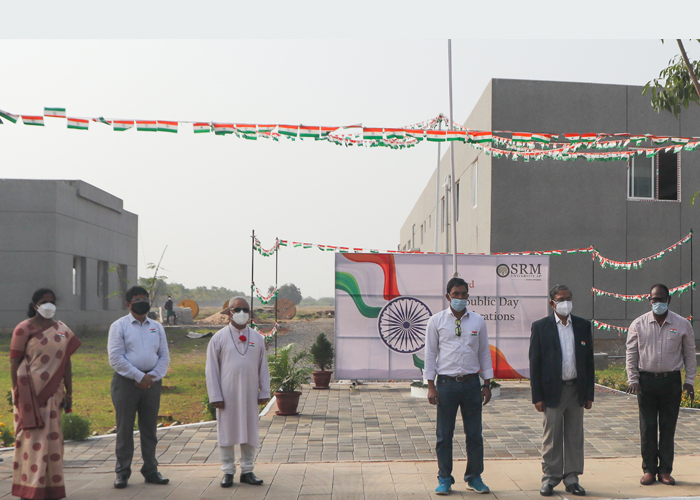 On January 26, 2022 at 9.00 am IST, SRM University-AP celebrated 73rd Republic Day Celebrations with a display of strong unwavering patriotism with all protocols in place. All the staff members and students came together virtually to honour our constitution, our culture, and the celebration of our unity in diversity.
On January 26, 2022 at 9.00 am IST, SRM University-AP celebrated 73rd Republic Day Celebrations with a display of strong unwavering patriotism with all protocols in place. All the staff members and students came together virtually to honour our constitution, our culture, and the celebration of our unity in diversity.
The event was an auspiciously planned by the Department of Student Affairs. The flag was unfurled and it was followed by the National Anthem.
- The priority was given towards good health and good physical practices on this Republic Day and a note on the importance and providence of Yoga was provided by Dr Venkat Nori who then guided everyone through the various steps of Surya Namaskar. Dr Nori’s elaborate and passionate detailing of integrating Yoga into our 21st Century Lifestyle with a refreshing take on its growing necessity was a crucial message to not only the students of SRMAP but to the country as a whole.
- The song by Sowmyadeep in his ethreal voice and with the heart pulling lyrics of “Desh Mere” brought a flair of lightness to the occasion.
- In an incredible show of solidarity and togetherness with the whole country and with the SRMAP digital version of the Republic Day parade the students worked hard and prepared informative State Tableaus to represent and celebrate our diversity.
- The dances by Navya and Prasanna transported us out to a world of music and beauty with a show of the creative range that our students have that extends beyond their academics.
- The song by Sruthi was another delicately woven melody that pulled on our heart stings. It was nostalgic and reminded us about what we as a country are striving towards.
- The short movie on Freedom by Movie club was remarkable in executing such brilliance despite the social distancing restrictions in place and is a show of our collective creative strength in face of challenges.
The event came to a close with a mixture of touching and motivating moments. It brought our love for our country and our responsibilities towards it to the forefront of our mind. But most importantly, it gave us the optimism to make our country a better place as we tackle the adversities of today and stay connected.
- Published in News


